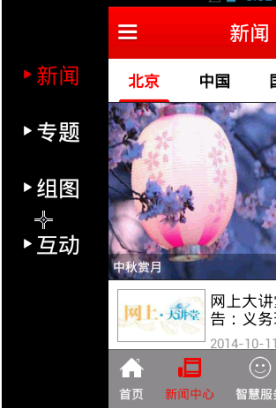

fragment的生命周期:
onAttach()当fragment添加进Activity的时候调用(这个时候Activity对象已经存在了,不然就依赖不上去的)
onCreate()当fragment创建的时候调用。
onCreateView()当fragment画界面的时候调用。
onActivityCreated()当fragment依附的Activity创建完成的时候调用。
onStart(),onResume(),onPause(),onStop(),onDestroyView(),onDestroy().
onStart()对着onStop(),
onResume()对着onPause(),
onDestroyView()对着onCreateView(),
onDestroy()对着onCreate()。
Mainactivity
package com.itheima.zhbj52; import android.os.Bundle; import android.support.v4.app.FragmentManager; import android.support.v4.app.FragmentTransaction; import com.itheima.zhbj52.fragment.ContentFragment; import com.itheima.zhbj52.fragment.LeftMenuFragment; import com.jeremyfeinstein.slidingmenu.lib.SlidingMenu; import com.jeremyfeinstein.slidingmenu.lib.app.SlidingFragmentActivity; /** * 主页面 */ public class MainActivity extends SlidingFragmentActivity {//使用开源SlidingMenu框架实现侧边栏, private static final String FRAGMENT_LEFT_MENU = "fragment_left_menu"; private static final String FRAGMENT_CONTENT = "fragment_content"; @Override public void onCreate(Bundle savedInstanceState) { super.onCreate(savedInstanceState); setContentView(R.layout.activity_main);//主页面是一个空的FrameLayout,后面会用Fragment填充。 setBehindContentView(R.layout.left_menu);//侧边栏也是一个空的FrameLayout,后面会用Fragment填充,SlidingFragmentActivity这个库的方法,设置左侧边栏布局。 SlidingMenu slidingMenu = getSlidingMenu();// 获取侧边栏对象 slidingMenu.setTouchModeAbove(SlidingMenu.TOUCHMODE_FULLSCREEN);// 设置主屏幕可以全屏触摸进行滑动, slidingMenu.setBehindOffset(200);// 设置预留屏幕的宽度,左右侧边栏滑动的时候主屏幕最少有100像素。 initFragment(); } /** * 初始化fragment, 将fragment数据填充给布局文件 */ private void initFragment() { FragmentManager fm = getSupportFragmentManager(); FragmentTransaction transaction = fm.beginTransaction();// 开启事务 //fl_left_menu和fl_content位于不同的xml transaction.replace(R.id.fl_left_menu, new LeftMenuFragment(), FRAGMENT_LEFT_MENU);// 用fragment替换framelayout,FRAGMENT_LEFT_MENU是名字。 transaction.replace(R.id.fl_content, new ContentFragment(), FRAGMENT_CONTENT); transaction.commit();// 提交事务 // Fragment leftMenuFragment = fm.findFragmentByTag(FRAGMENT_LEFT_MENU);根据名字找fragment, } }
activity_main.xml
<?xml version="1.0" encoding="utf-8"?> 空布局,就是一个容器。 <FrameLayout xmlns:android="http://schemas.android.com/apk/res/android" android:id="@+id/fl_content" android:layout_width="match_parent" android:layout_height="match_parent" > </FrameLayout>
left_menu.xml
<?xml version="1.0" encoding="utf-8"?> 空布局,就是一个容器。 <FrameLayout xmlns:android="http://schemas.android.com/apk/res/android" android:id="@+id/fl_left_menu" android:layout_width="match_parent" android:layout_height="match_parent" > </FrameLayout>
LeftMenuFragment
package com.itheima.zhbj52.fragment; import com.itheima.zhbj52.R; import android.view.View; /** * 侧边栏 * * @author Kevin * */ public class LeftMenuFragment extends BaseFragment { @Override public View initViews() { View view = View.inflate(mActivity, R.layout.fragment_left_menu, null); return view; } }
fragment_left_menu.xml
<RelativeLayout xmlns:android="http://schemas.android.com/apk/res/android" xmlns:tools="http://schemas.android.com/tools" android:layout_width="match_parent" android:layout_height="match_parent" android:background="#f00" > <TextView android:layout_width="wrap_content" android:layout_height="wrap_content" android:text="我是侧边栏!" /> </RelativeLayout>
ContentFragment
package com.itheima.zhbj52.fragment; import com.itheima.zhbj52.R; import android.view.View; /** * 主页内容 * * @author Kevin * */ public class ContentFragment extends BaseFragment { @Override public View initViews() { View view = View.inflate(mActivity, R.layout.fragment_content, null); return view; } }
fragment_content.xml
<RelativeLayout xmlns:android="http://schemas.android.com/apk/res/android" xmlns:tools="http://schemas.android.com/tools" android:layout_width="match_parent" android:layout_height="match_parent" > <TextView android:layout_width="wrap_content" android:layout_height="wrap_content" android:text="我是主页面哦!" /> </RelativeLayout>
BaseFragment
package com.itheima.zhbj52.fragment; import android.app.Activity; import android.os.Bundle; import android.support.v4.app.Fragment; import android.view.LayoutInflater; import android.view.View; import android.view.ViewGroup; /** * fragment基类 */ public abstract class BaseFragment extends Fragment { public Activity mActivity; // fragment创建 @Override public void onCreate(Bundle savedInstanceState) { super.onCreate(savedInstanceState); mActivity = getActivity();//拿到fragment所依赖Activity的对象,fragment创建创建的时候Activity对象肯定是已经存在了,所以这个对象不会是空的。 } // 处理fragment的布局 @Override public View onCreateView(LayoutInflater inflater, ViewGroup container, Bundle savedInstanceState) { return initViews();//子类实现,因为每个布局不一样。 } // 依附的activity创建完成 @Override public void onActivityCreated(Bundle savedInstanceState) { super.onActivityCreated(savedInstanceState); initData(); } // 子类必须实现初始化布局的方法 public abstract View initViews(); // 初始化数据, 可以不实现 public void initData() { } }